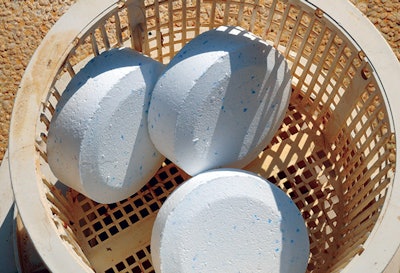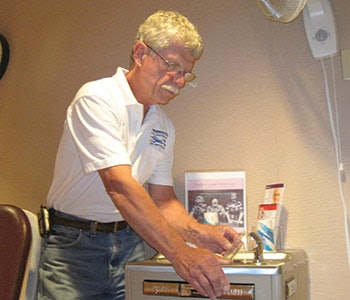
The Southwest drought has focused our attention on the practice of draining pools. In some California counties it's flat-out illegal; in the rest of America, it's merely expensive.
Just to recap the situation in bone-dry California, a growing list of municipalities have banned the practice of draining and refilling pools. Even where it remains legal, draining is frowned upon in a state that is now serious about its water supply. Pool water running down the sewer looks like wanton waste to people who are buying low-flow shower heads and conserving flushes, and the pool industry is in the political fight of its life.
There is less drama in the Midwest and Northeast, blessed by abundant supply, but it still costs a fair amount of time and money to refill a pool with fresh water. So it's in everyone's interest, whether they live in the wet or the dry regions, to try to keep the water in the pool.
Covering the pool to reduce evaporation is by far the best way to fight water loss, but everybody knows that. What's less understood, and the subject of this story, is how the choice of sanitizer and water care methods can affect water conservation.
Every year millions of gallons of pool water are simply poured out into the sewer or down the back slope either to drop the waterline below the skimmer for winterizing or, more often, to drain and refill with fresh water to fight the buildup of contaminants — usually calcium/minerals or cyanuric acid (CYA).
Different chlorine products exacerbate this buildup. For instance, the use of calcium hypochlorite (cal-hypo) will lead to higher levels of calcium in the water, a particular concern in hard water regions of the country. One pound of cal-hypo in a 10,000-gallon pool will increase hardness by 4 ppm and TDS by 12 ppm.
By the same token, popular tri-chlor and di-chlor tablets add CYA to pool water. This has long been regarded as a good thing: CYA stabilizes chlorine and slows its destruction under the sun's UV rays, but CYA will build up over time to a problematic level. In fact, the new Model Aquatic Health Code, the final authority on pool care, says, "The cyanuric acid level at all aquatic venues shall remain at or below 100 ppm." (Emphasis ours.) While this regulation refers to commercial venues, which are regularly inspected and monitored for compliance, the point is valid for backyards as well, where high levels of CYA interfere with chlorine's ability to kill and oxidize.
In the past, when time and resources were less precious, the resulting drain and fill was taken as a matter of course, and the issue received less attention. Now, opinions are changing. Steve White, owner and president of Underwater Pool Masters, West Boylston, Mass., has seen the problem close-up from the service side.
"We have hundreds of pools set up using tri-chlor tabs with feeders, and our customers have always loved the simplicity and the overall water quality — not to mention it's a good revenue stream. But we are also very aware of the high-levels of cyanuric acid that build up as a result of the use of tri-chlor tabs. And as that cyanuric acid builds up in the water, the chlorine becomes less effective and the result is fairly obvious when the pool starts to quickly develop algae. This then leads to treating the algae with an algaecide. It's a vicious circle."
In the past, White's company would drain down pools and add fresh water to deal with the problem, but due to problems will municipal water in his area, that's becoming a less attractive option.

"In our area in particular, the counties are using products to remove metals from our source water because consumers don't like to see metal staining in their sinks," he says. "But these metal removers are heavy in phosphates, so adding source water often leads to adding high levels of phosphates to the pools, which, once again, leads to algae. There really isn't an easy answer."
Too Much Conditioner
At the opposite end of the continent, in the upscale neighborhoods of Beverly Hills, Torrell Lebron of Crystal Clear Pool & Spa looks to avoid draining for different reasons — SoCal water is not only scarce but also increasingly expensive.
"We try to keep draining down to a minimum because the water bill is pretty crazy out here right now for refilling pools," he says. "But I know a lot of service guys that, when the weather gets hot and sunny, they just fill up their chlorinators with tri-chlor tabs and let it run. And they end up with a high conditioner or CYA level at the end of the year. And then they have to drain it.
"It becomes routine. I've picked up new customers who would ask me at the end of the season, 'Well, is it time to drain the pool? Every year about this time, my pool guy usually drains a couple feet out of the pool.' And that's because the guy was just using tri-chlor tablets, letting the conditioner build up, and then draining it."
There's a profit motive involved in this system as well, Lebron notes. "A lot of service guys charge separately for conditioner (CYA), no matter how it's applied, and it's a big money-maker. And for that reason, a lot of guys are not going to want to stop using it and charging for it because it helps the bottom line."
A Possible Solution
A new entry in the pool market may provide the answer, however. Bio-Active Cyanuric Acid Reducer has generated a real buzz in the industry as a product that may be able to reduce CYA levels without the need to drain the pool and draw fresh, expensive, scarce water.
Experience with Bio-Active is still limited, but reports from the field have been encouraging. According to a written testimonial from Steve Valsvig, owner of Valley Pools, Rancho Mirage, Calif., his company "took a pool with a CYA reading of 140 ppm down to 40 ppm in 24 hours using Bio-Active. Putting a package of product in the skimmer instead of draining has been a game changer for me. I've been in the pool business for over 30 years, and this is the greatest product I've ever seen."
Bio-Active is actually made up of microorganisms that eat cyanuric acid, so to use the product, you have to make sure that you don't kill the microorganisms before they do their work.
"Just like any organism, they need a certain environment to live and consume cyanuric acid, says Jose Torres, technician at manufacturer Solar Sun Rings, Temecula, Calif. "We state on the package that the water needs to be 68 degrees in order to work properly. And the chlorine level should be less than 5 ppm, so you shouldn't use it right after you shock the pool."
RO To Go
Beyond water chemistry, another drain-avoidance technology gaining new adherents is the incredibly fine filtration provided by reverse osmosis. RO filters remove contaminants down to a fraction of a micron and have the ability to strip water of almost everything but the H and the two Os, including minerals, CYA, phosphates and calcium.
A new breed of companies have developed trailer-mounted RO systems that pull up beside the pool, pump water onboard, run it through the RO filter, and back into the pool in a very pure state, obviating any need to drain and refill.
With increasing pressure on water supplies in the Southwest, and the natural evolution of procedures toward those that are less costly, RO and products like Bio-Active are in growth mode; service companies are examining water care in light of conservation, because the convention of pouring pool water down the sewer is unsustainable in the long term.
Commercial Implications

Particularly if the drought worsens, public pools in Southern California are likely to come under strong pressure, says Terry Arko, recreational product specialist for SeaKlear Pool and Spa Products, Bothell, Wash.
"I heard about a municipal pool in Southern California that was told they had to reduce their water usage by 30 percent or else. I think things like that may become more prevalent — waterparks, places like that being targeted for reduction in water use."
Due to the fact that those public facilities are regulated and they have strict limits on CYA and calcium levels, he adds, they will have to be carefully managed because they won't be able to drain.
"The problem is that public pools are going to be inspected and held to the 100 ppm CYA maximum (MAHC mandates less than 100 ppm, and some places demand less than 50 or even 30 ppm) but at the same time, they may not be allowed to drain and refill. And there are no proven methods of lowering CYA except for draining, especially on large pools."
Comments or thoughts on this article? Please e-mail [email protected].












































